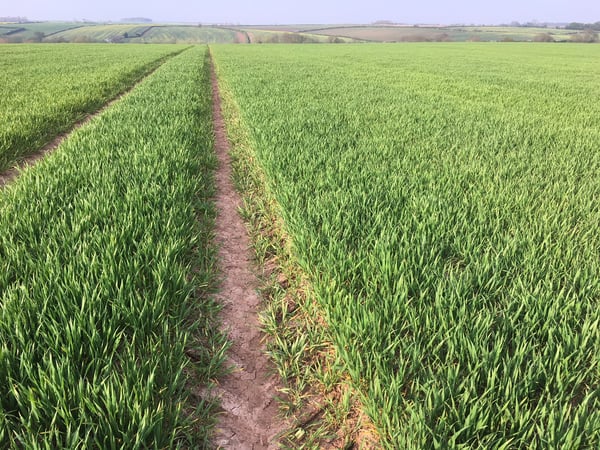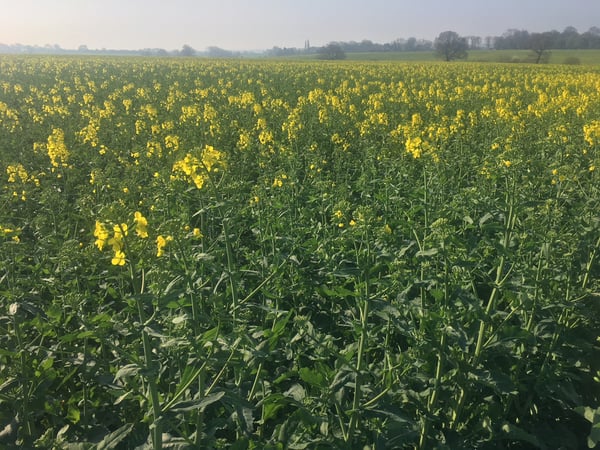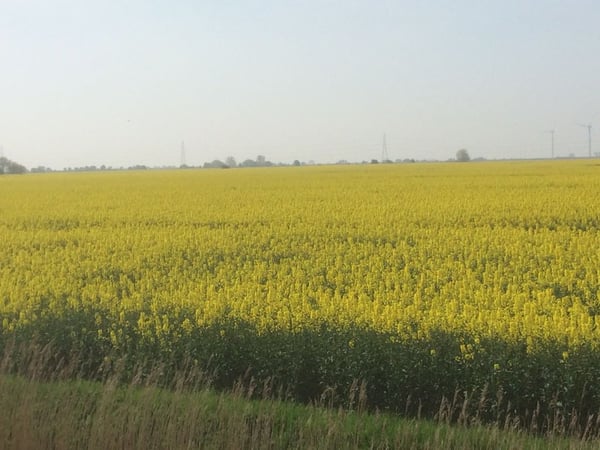2018 - Enhancing wheat yields - an interview with the growers

In this week’s update, we catch up with three of Adama’s sponsored YEN* growers to find out how their crops have coped with the extended winter weather and how they are progressing now that spring has finally arrived.
Ian Holmes is the in-house agronomist for Strawson Limited. The business farms around 5,000 acres of arable land in Nottinghamshire and neighbouring counties alongside a significant vegetable and potato growing operation. The business’s arable rotation on heavier land is based around winter wheat, oilseed rape and spring cereals with smaller areas of winter barley and hybrid rye.
Alan Clifton-Holt farms 1,053 hectares of silt and silty clay soils on the Romney Marsh in Kent, plus an additional 162ha of ‘upland’ Kent countryside with soils ranging from heavy clay to sand. Crops grown include winter and spring wheat, spring barley, OSR, combinable peas, cover crops and grass leys.
Iain Robertson is Assistant Arable Manager for David Foot Ltd in Dorset. The mixed farming business consists of two farms totaling 1,600 hectares. A herd of 970 dairy cows is supported by a rotation of Wheat – OSR – Maize – Spring Barley – Winter Barley – Beans, grown predominantly to feed the expanding dairy enterprise.
ADAMA: when did you drill your winter crops, and what were the conditions like?
 IH: Our autumn drilling plans were delayed due to wet weather in August and September. Oilseed rape was largely drilled in the last week of August but wasn’t completed until mid-September. Wheat drilling did not start until 7th October: this was perhaps more helpful for black-grass control, and we were fortunate to have an open, late autumn so conditions in mid-late October were better than September or early October. Drilling on our heavier land was completed by the first week in November, although drilling on sand land after potatoes, maize and sugar beet continued into December.
IH: Our autumn drilling plans were delayed due to wet weather in August and September. Oilseed rape was largely drilled in the last week of August but wasn’t completed until mid-September. Wheat drilling did not start until 7th October: this was perhaps more helpful for black-grass control, and we were fortunate to have an open, late autumn so conditions in mid-late October were better than September or early October. Drilling on our heavier land was completed by the first week in November, although drilling on sand land after potatoes, maize and sugar beet continued into December.
AC-H: We drilled the first of our Group 3 winter wheats during the last week of September at a rate of 180 seeds/m2, with the remaining ground being drilled at the beginning of November (225 seeds/m2) to provide a 6-week period during which stale seedbeds were sprayed off to counter any black-grass infestations. At both timings, crops were drilled in near perfect conditions.
IR: Since the beginning of September we’ve only had one completely dry week so we’ve been working in some very wet conditions. We started drilling wheat at the end of September: we would usually use a two-pass (min-till followed by drill) system, but this year we had to power harrow as much as 50% of our wheat ground to form a decent seedbed. We sow a lot of our wheat after maize, and after a battle to harvest the maize in wet conditions, and an even bigger battle trying to create decent seedbeds from the maize stubbles, we still had land to drill in December. By then it was simply too wet to work so the last of our winter wheats went in at the end of November.
ADAMA: did your winter crops establish as expected?
IH: Winter crop establishment has generally been good, with some variability. Oilseed rape establishment has been a bit of a mixed bag, with drilling date dictating performance: our September drilled crops are behind in terms of growth stage, but they have produced reasonable plant numbers. Our October-drilled wheats have strong plant populations and good tiller numbers – so plenty of potential. Maintaining and managing tillers in wheat has been a priority in the early part of the spring. Wet winter conditions will have potentially restricted root development: this is a potential concern for wheats on lighter land which might suffer if May and June turn out to be very dry.
 Ian Holmes YEN wheat field - picture captured 21st April 2018
Ian Holmes YEN wheat field - picture captured 21st April 2018
AC-H: All our crops went into the winter looking well. We’ve experienced some swan damage in our oilseed rape, but otherwise it was ‘business as usual’.
IR: Overall, the majority of our wheats have established well, despite the wet conditions. Our saving grace is that our South Dorset location means air and soil temperatures remain a couple of degrees higher than the national average. That has made a significant difference this year, especially during the colder snaps of weather.
ADAMA: how did the wet, cold and snowy conditions affect crop performance and timings during the extended winter?
IH: Overall, we managed to make all our planned crop protection applications in the autumn and winter. Pre-emergence herbicide performance has generally been good and our planned Avadex applications were made to help black-grass control where necessary. Activity from propyzamide in oilseed rape has produced some good results, with performance helped by air and soil temperatures remaining low into spring. Wet conditions since the turn of the year have delayed early spring applications and have meant very little post-emergence weed control has been made in winter wheat.
AC-H: Unlike the majority of the UK, we saw very little snow in south east Kent. Biting easterly winds did hold the crops back for a while, and the ground remained wet throughout the winter, but we are predominantly farming a marsh anyway so the wet conditions were nothing new for us.
IR: Despite the lengthy winter, we haven’t had much more precipitation compared to an average year. Thankfully the rain we’ve had has come down as a constant and steady trickle rather than excessive deluges, which means the fields are now drying out nicely and are no wetter than in previous years.
ADAMA: how are your crops coping with pressures from septoria, rust, mildew, etc?
IH: We’re using less susceptible varieties such as Siskin, Graham and Crispin over a wider area which has helped to keep disease levels in wheat relatively low. Yellow rust was checked by the cold conditions in February and March, although susceptible varieties, notably Reflection, had active yellow rust at the start of April and have had a robust T0 application to counter this. In oilseed rape, Light Leaf Spot levels were low pre-Christmas, and although the disease started to appear after Christmas, a March fungicide application seems to have kept levels at bay for now.
AC-H: We’ve been very pleased so far: all our crops have remained very clean with just a small amount of septoria present in the lower leaves of some of our wheats. We applied a T0 treatment at the beginning of April and will be applying a T1 spray imminently.
IR: Crops have remained surprisingly clean so far. We’ve seen some septoria in the lower leaves of wheat, but nothing that’s causing us too much concern. We applied a T0 treatment to one block of land, just to keep on top of things, but for most of our land, a T0 wasn’t needed. The cold weather stopped plants from growing during the winter, and it was so wet we couldn’t have applied a T0 on a lot of land if even if we’d needed to. More recently, crops have grown away so rapidly that they’ve jumped through their growth stages before diseases have had a chance to take effect. Thankfully, the lack of disease has meant we can focus on getting our weed control applications made in good time.
Adama: how has the late start to spring affected your crops, workloads and strategy?
IH: The delayed spring has certainly affected workloads, with delays to spring crop establishment in all crops and on all soil types. Wheat crops have reached GS30 around 10-14 days later than our norm, with T0 applications completed during the week beginning 16th April. The gap to T1 is likely to be short and I expect to apply these in the first week of May. First nitrogen applications were also delayed well into March, later than our normal plan for these to be applied at the end of February. Our barley and rye crops have now had their T1 applications. Oilseed rape has finally started to flower and is receiving an early flower fungicide to top up Light Leaf Spot protection.
The winter’s biggest impact has been in terms of delaying weed control, with the colder spring conditions preventing us from making applications. Wheat weed control will largely fit in with T1 fungicide applications.
Nitrogen applications on oilseed rape and winter barley are now up to date, and we are part-way through making our middle splits of N on wheat: we are considering doubling-up our second and third splits to reduce the number of passes required, save time and reduce workloads.
Spring drilling has been significantly delayed, with late potato plantings and sugar beet drilling giving cause for concern in terms of the potential for yield limitation. A lot of our heavier land, where spring crops have been drilled as part of a black-grass control strategy,remains frustratingly wet which means we’ve got some difficult decisions to make in terms of whether to leave land fallow. Where spring crops have been drilled, it’s hard to believe yield impacts will not be noticeable.
AC-H: We’re pretty much up-to-date with all our spring activities. The only amendment we’ve had to make to our initial plans is to reduce the spring fertiliser programme from a 4-way split down to a 3-way split. Other than that, the extended winter and late spring have had very little impact on proceedings.
ADAMA: what are your current priorities and challenges?
IH: Our main priorities at the moment are focused on spring crop establishment – particularly potatoes, sugar beet and root vegetables. Spring cereal drilling is finally progressing but is still being limited by field conditions. With fungicide applications now up to date on winter crops, the main priority is managing nitrogen inputs and trying to streamline applications to manage workloads. Maintaining tiller counts in wheat will be an important part of final yield performance: although we have had to be very patient while waiting for temperatures to warm and soil conditions to dry, we are conscious that a very dry spell into May and June would not be helpful for crop yield development, particularly for spring sown cereals or those sown later on light land which have not had to work hard to develop root systems. Oilseed rape crops are now at the early flowering stage (around a month later than 2017 and 10-14 days later than ‘average’) – our main focus here is on continuing to protect against Light Leaf Spot and Sclerotinia. I would suggest we are unlikely to cut much, if any, oilseed rape by the end of July.
 Ian Holmes YEN OSR field - picture captured 21st April 2018
Ian Holmes YEN OSR field - picture captured 21st April 2018
AC-H: Our oilseed rape crops have been in full flower for the best part of a fortnight and we’ll be starting T1 wheat treatments within the next few days. There are still a few pockets of ponding on some of the farm’s wettest land but we’re used to dealing with that sort of challenge. Our soils never really dry out so, by and large, it’s been a fairly typical season for us so far. It’s too early to tell how much of a yield penalty we’ll incur on the land where drilling was delayed until the beginning of November, but all crops are looking strong and healthy so far, so fingers crossed we’ll see decent results across the board.
 Alan Clifton-Holt YEN OSR field - picture captured 22nd April 2018
Alan Clifton-Holt YEN OSR field - picture captured 22nd April 2018
IR: Our primary concern in recent weeks has been to get our spring weed controls applied. If the weather had carried on being catchy we would probably have needed to apply a T0 spray which would have meant another pass on the sprayer. We use cover crops on the farm’s 600 hectares of maize ground which means we already have an extra sprayer pass before the maize drill can go back in. Fortunately, things started to dry out and heat up just at the right time so we’ve been able to catch up with things by forgoing the T0 application. Despite that, the last two weeks have been fairly manic, with 14+ hour spraying days needed to ensure I’ve been able to get everything done. The next job is to get our T1 sprays applied, and to apply pre-emergence herbicides to the freshly drilled maize ground. Thankfully it’s all looking like it’s going to be worth it – the crops are looking remarkably good despite the winter weather, so it’s definitely a ‘glass-half-full’ season so far!
* Yield Enhancement Network.
 United Kingdom
United Kingdom Select country
Select country



